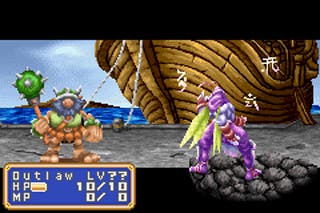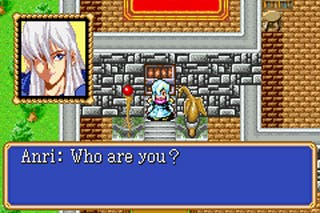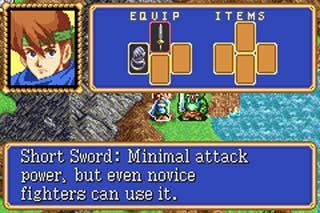Shining Force: Resurrection Of The Dark Dragon
A GBA remake to treasure.
Classic franchises are a bit like children in an old country village. (Yes, this is going somewhere). One day there’s an abundance of them, vying for more attention but never getting it - and then the next, they’re gone. Grown up, forgotten, left for the big city. Suddenly, the old country village is in a spot of trouble; without children, it has no future; without them, it will not survive.
And so, the remaining children are treated like gold, because now the village finally realises their true value. Awwww. Anyway. There aren’t too many classic franchises left in the games industry, and it’s growing harder and harder to create one from scratch.. Most have already been revived, but for every Ninja Gaiden there’s a Shinobi. Which probably explains why Sega is being so clever with the Shining series. Not only has it teased us about a new PS2 Shining Force game, due in 2005, but it has also gone and remade the original Mega Drive game for the GBA. And, judging by the treatment it has received, this is one child that won’t be leaving the village. (Enough! - Ed).
May the force be with you

Shining Force wasn’t the first game in its series (that claim belongs to dungeon-romp Shining in the Darkness) but most fans will agree it was the one that stole our hearts. It took the story-driven, town-roaming antics of the Final Fantasy series and merged it with a compelling chess-like battle system. It pioneered the strategy RPG genre - yet, ironically, most subsequent SRPGs have failed to replicate its charm. That fact is only re-enforced by this GBA remake which, despite some welcome additions, is all but identical to the original game.
Resurrection of the Dark Dragon is a very simple game at heart. You play Max, a young warrior who suffers from amnesia. He has been living in the town of Guardiana, the head of the Guardiana empire, having been taken in by its king. His past is shrouded in mystery (well, what did you expect?) and before long he is made leader of the Shining Force army, swept up in a battle against the warlike Runefaust empire … and maybe something greater. As with any good RPG, the plot in Shining Force is strong, but what really makes it stand out are the assortment of characters involved, and the way their plight is magnified by the epic nature of the battles. It’s the wonderful balance between town-roaming and combat that made the original a classic, and that stands for this version too.
A force to be reckoned with

The game’s structure is quaintly straightforward, but satisfying nonetheless. Broken into eight chapters, it basically follows a town-battle-town-battle system, whereby you further the story and recruit allies in explorable towns, and then, erm, engage in battle.
The latter aspect of gameplay is at the heart of Shining Force, and it’s best described as a kind of freeform, fantasy chess. Early on the game, you’ll only have a handful of characters to fight with, starting off with two basic warrior classes, a wizard and healer. However, as you progress, up to 12 allies can be taken to battle at any one time, from an eventual selection of over 30 (if you can find them all, that is).
Generally speaking, a battle has the Shining Force grouped at one end of a large area, and various enemies scattered over the rest of it, often with a leader or boss enemy at the far end. Both enemies and allies can only move a certain number of spaces on the battle area (depending on terrain type and stats) and can only perform one action per turn. Mainly, it’s just a case of defeating all the enemies - though in some instances defeating a specific enemy will also end the battle.
Late Bird Catches The Flak

Every ally, like every enemy, has different strengths and weaknesses, and the proper use of them is necessary to fight a successful battle. For instance, an archer might be able to attack an enemy from two spaces away, but he won’t survive much punishment in close quarters. Similarly, at the sufficient level, wizards can cast spells like Sleep and Fire at multiple opponents - but their health and defence are rubbish. As characters level up - which happens roughly every two kills or so, to a point - they gain new abilities and improve their existing ones.
Of course, all that probably sounds like typical strategy fare, but what makes Shining Force so special is the variety of characters you can recruit. Not all are straightforward wizards or healers; there’s a baby dragon, a jellyfish thing, a werewolf; you get the idea. Each character has a fleshed-out personality, plus most can be ‘promoted’ to new classes once they reach a certain level. You’ll soon find yourself taking a liking to specific characters, and including them in every battle. The downside to this is that new characters you recruit are sometimes ignored … but you can always concentrate on them the second time through.
The differences between the remake and the original are relatively minor. The first thing fans will notice is that Max actually talks in this outing - quite a bit in fact. He never gets into full-blown conversations or anything, but I preferred him mute. Amusement Vision has handled his newfound confidence well, however, and first-time players won’t bat an eyelid at it. Elsewhere the main changes are to the battles. Firstly, almost all of them now have a ‘challenge’ objective that you can fulfil to earn prizes. This mostly consists of ‘defeating all enemies’ within a certain number of rounds, and the prizes are weapons or gold. Lastly, and most interestingly, are the three new characters. Two of them, Narsha and Zuika, are utterly boring, despite the extra plot details Narsha brings to light.
Play your cards right

However, the third, Mawlock, is an excellent addition. Throughout the game, you’ll acquire cards by searching town areas and defeating enemies, although some need to be killed by specific characters in order to slay them. Mawlock can equip these cards for battle, to ‘clone’ allies, copy enemy abilities and generally open up a new dimension to battles - which also get harder if you use Mawlock’s abilities. Additionally, a New Game+ option lets you play the game through a second time, in order to find the cards you didn’t get initially.
Graphically, the game has been given a slight facelift, but only barely. This is a good thing. The original was bright, colourful and had excellent battle animations. Thus, the same can be said of this version - though the GBA is obviously capable of better.
A special word must also be said of Shining Force’s music, which is probably the best soundtrack the Mega Drive was privvy to. Without that, perhaps many of the battles - and even the plot itself - may have lost some of its edge. A shining example of retro gaming
Double trouble

Shining Force is a true classic. It may not have the admirable depth of Final Fantasy Tactics Advance or Fire Emblem, but it has twice the character - and twice the fun. Its story and graphics may not match the complexity of Golden Sun, but its simple poignancy more than makes up for it.
Even if Amusment Vision had done nothing to change the original, this would be one of the best games on the system. As it is, it has somehow managed to improve it without compromising the retro goodness. If classic franchises are like children, then this kid deserves all the attention he gets. (shoot me - Ed).







